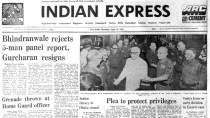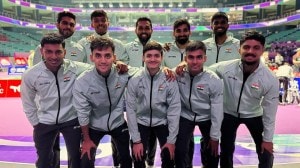- India
- International
The Haryana model
Its politics retains its oddity but the assembly election has brought the state into the national mainstream
 The BJP gained by recognising that Haryana is undergoing a transition, as one of the fastest urbanising states. (Source: PTI)
The BJP gained by recognising that Haryana is undergoing a transition, as one of the fastest urbanising states. (Source: PTI)
If we have a “Haryana model” of electoral politics, what are its distinctive characteristics? To what extent do these characteristics enable us to put in perspective the 2014 assembly election results and discover perceptible shifts, if any?
Let us discuss the “exceptionality” factors. First, though identities based on caste and kinship do play a strong role in Haryana, the process of identity-formation and political consciousness among Dalits, constituting 19.3 per cent of the state’s population, or the backward castes, has remained nascent. So Haryana has not yet experienced their assertion. Second, the proximity and economic integration with the NCR region of Delhi has accorded a satellite-like character to the state’s politics, undermining its strong regional political identity.
Third, instead of historically constituted social, cultural and economic regions forming distinct electoral regions, it is the administrative districts that seem to have emerged as electoral units in Haryana, closely identified with a particular community, leader and his clan. Fourth, unlike the emergent electoral bipolarity at state and Central levels, Haryana continues to witness extreme fluidity in terms of the party system — state-level parties appearing and disappearing on a regular basis, opportunistic alliances being formed and broken, and party-hopping being the order of the day. Fifth, the BJP has had (until this assembly election) an insignificant and inconsistent electoral presence. Sixth, the state’s party system remains fluid, as evident in the lack of a stable competitive structure, or any long-term alignment of the electorate with a party. The relationship of voters with parties seems pragmatic — the electorate makes an assessment of a party’s capacity to keep its word. Electoral choices in Haryana have been a “flow variable” rather than a “stock variable”, keeping politicians and parties on their toes.
The 2014 assembly election has confirmed the above trends, imparting a singularity to the “Haryana model”. Confirming the lopsided nature of Haryana’s politics, the BSP has continued to fare badly in a state with 17 reserved seats. It has remained a fringe player, winning one seat. The BSP also slipped in vote percentage from 6.73 to 4.4 per cent. That this year’s figure of 13 victorious women candidates in Haryana’s 90 seats is the highest in the state’s electoral history shows that the gender deficit prevails in politics too.
The “Delhi factor” was evident, as Haryana once again voted for a party leading the Central government, which has been a strong votary of economic reforms that have benefited the state. The tendency of administrative units to become electoral units was confirmed, as leaders across parties were identified with their “own” districts and accused of helping their districts alone when in power, as in the case of Bhupinder Singh Hooda. Although districts have shown their distinct electoral patterns in the past, the BJP juggernaut this time somewhat flattened the electoral boundaries.

The volatile nature of electoral politics in Haryana was visible in the fact that two new state-level parties — the Haryana Jan Chetna Party and the Haryana Lokhit Party — joined the fray and that, post-performance, they seem ready for oblivion. It was also visible in the drastic fluctuations in the electoral fortunes of other parties. The BJP has moved from two and four seats won in 2005 and 2009, respectively, to 47 seats. The Congress, which had 67 and 40 seats in 2005 and 2009, respectively, has managed to win 15. The INLD, waiting in the wings to make the most of the Congress’s debacle, slipped further from 31 seats to 19.
In a state branded for its “aaya Ram-gaya Ram” politics, party-hopping continued unabated, with the BJP being the beneficiary as in the Lok Sabha elections. For the Lok Sabha, the BJP had given tickets to four candidates who had defected from the Congress and were rewarded with victories. This time, the number of deserters joining the BJP and getting tickets was 47, most of them doing well because of the “Modi wave”. It shows deserting the party on election eve has become accepted.
While confirming the larger trends of the Haryana model, this election seems to indicate that, for the first time, the usual determinants of electoral politics, like caste, community and clan, failed to sway voters. It was best reflected in the dismal fate of the INLD, very much a “khap” party. The BJP’s campaign, spearheaded by Narendra Modi in the last days, ran on national issues like development, good governance, corruption/ nepotism, jobs. As the outcome shows, it trumped the traditional mode of campaigning by the INLD and the Congress.
The BJP apparently gained from recognising that Haryana is undergoing a transition. It is one of the fastest urbanising states, with a sizeable number of urban and rural middle-class voters, most of them young and aspirational. Invoking the famous Lal trio (Devi Lal, Bansi Lal and Bhajan Lal) could win the families a few seats, but not the state. So Haryana seems to have fallen in line with the national mainstream, while still retaining its oddity.
The writer is professor, department of political science, Panjab University, Chandigarh
EXPRESS OPINION
More Explained
Apr 26: Latest News
- 01
- 02
- 03
- 04
- 05










































